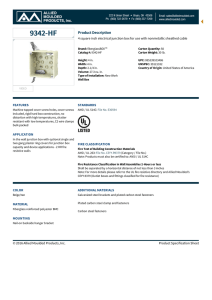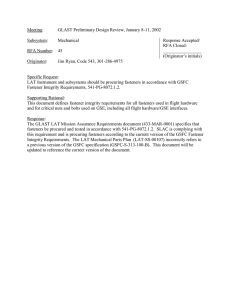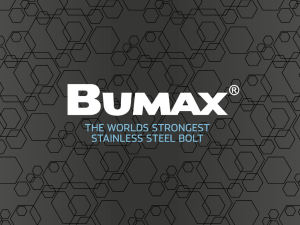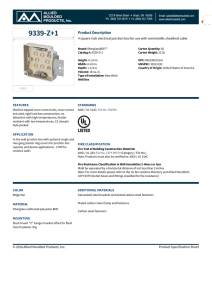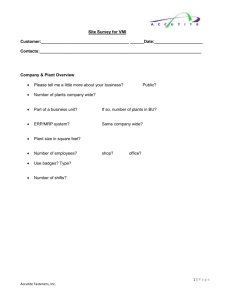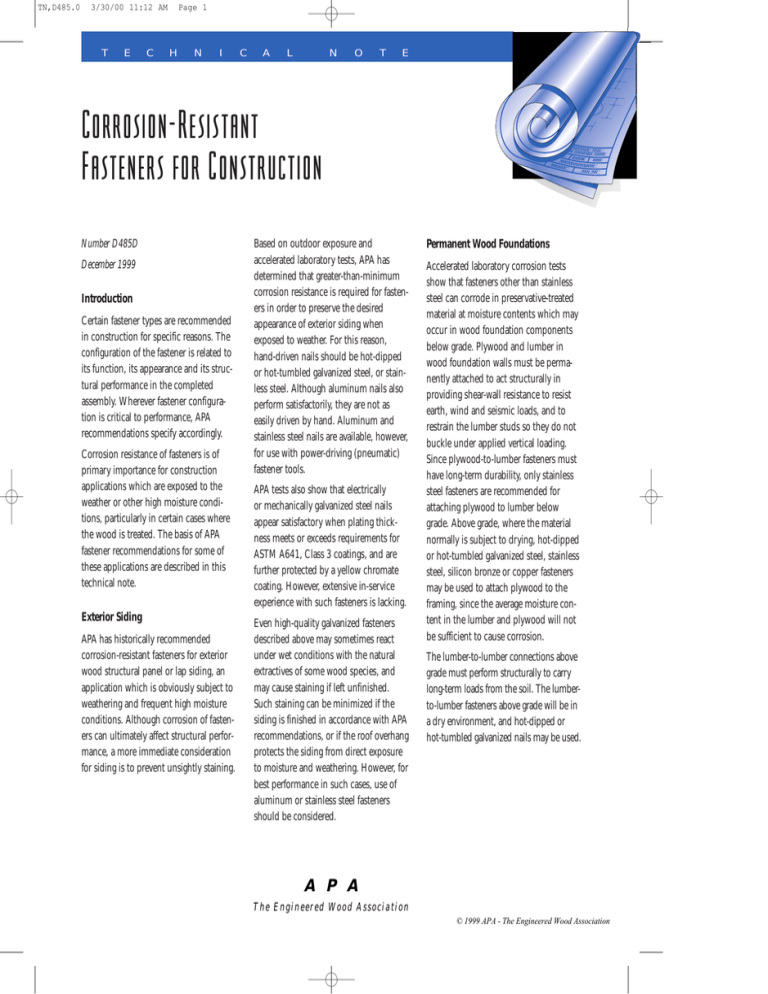
TN,D485.0
3/30/00 11:12 AM
T
E
C
Page 1
H
N
I
C
A
L
N
O
T
E
Corrosion-Resistant
Fasteners for Construction
Number D485D
December 1999
Introduction
Certain fastener types are recommended
in construction for specific reasons. The
configuration of the fastener is related to
its function, its appearance and its structural performance in the completed
assembly. Wherever fastener configuration is critical to performance, APA
recommendations specify accordingly.
Corrosion resistance of fasteners is of
primary importance for construction
applications which are exposed to the
weather or other high moisture conditions, particularly in certain cases where
the wood is treated. The basis of APA
fastener recommendations for some of
these applications are described in this
technical note.
Exterior Siding
APA has historically recommended
corrosion-resistant fasteners for exterior
wood structural panel or lap siding, an
application which is obviously subject to
weathering and frequent high moisture
conditions. Although corrosion of fasteners can ultimately affect structural performance, a more immediate consideration
for siding is to prevent unsightly staining.
Based on outdoor exposure and
accelerated laboratory tests, APA has
determined that greater-than-minimum
corrosion resistance is required for fasteners in order to preserve the desired
appearance of exterior siding when
exposed to weather. For this reason,
hand-driven nails should be hot-dipped
or hot-tumbled galvanized steel, or stainless steel. Although aluminum nails also
perform satisfactorily, they are not as
easily driven by hand. Aluminum and
stainless steel nails are available, however,
for use with power-driving (pneumatic)
fastener tools.
APA tests also show that electrically
or mechanically galvanized steel nails
appear satisfactory when plating thickness meets or exceeds requirements for
ASTM A641, Class 3 coatings, and are
further protected by a yellow chromate
coating. However, extensive in-service
experience with such fasteners is lacking.
Even high-quality galvanized fasteners
described above may sometimes react
under wet conditions with the natural
extractives of some wood species, and
may cause staining if left unfinished.
Such staining can be minimized if the
siding is finished in accordance with APA
recommendations, or if the roof overhang
protects the siding from direct exposure
to moisture and weathering. However, for
best performance in such cases, use of
aluminum or stainless steel fasteners
should be considered.
Permanent Wood Foundations
Accelerated laboratory corrosion tests
show that fasteners other than stainless
steel can corrode in preservative-treated
material at moisture contents which may
occur in wood foundation components
below grade. Plywood and lumber in
wood foundation walls must be permanently attached to act structurally in
providing shear-wall resistance to resist
earth, wind and seismic loads, and to
restrain the lumber studs so they do not
buckle under applied vertical loading.
Since plywood-to-lumber fasteners must
have long-term durability, only stainless
steel fasteners are recommended for
attaching plywood to lumber below
grade. Above grade, where the material
normally is subject to drying, hot-dipped
or hot-tumbled galvanized steel, stainless
steel, silicon bronze or copper fasteners
may be used to attach plywood to the
framing, since the average moisture content in the lumber and plywood will not
be sufficient to cause corrosion.
The lumber-to-lumber connections above
grade must perform structurally to carry
long-term loads from the soil. The lumberto-lumber fasteners above grade will be in
a dry environment, and hot-dipped or
hot-tumbled galvanized nails may be used.
A P A
T h e E n g i n e e r e d Wo o d A s s o c i a t i o n
© 1999 APA - The Engineered Wood Association
3/30/00 11:12 AM
Page 2
Lumber-to-lumber connections below
grade only carry loads during fabrication
and erection. After the final structure is
completed, the plywood-to-lumber
fasteners hold the lumber components
together. Consequently, the lumber-tolumber fasteners below grade may be
hot-dipped or hot-tumbled galvanized
steel nails. It is recognized that these
fasteners have less corrosion resistance
than stainless steel fasteners, but tests
have shown that the strength of shearwall assemblies are reduced very little,
even when certain lumber-to-lumber
fasteners are completely removed.
Lumber knee walls are sometimes used to
support brick veneer. In those cases, the
studs are toenailed to the wood foundation wall, and are directly exposed to the
soil. Lumber-to-lumber fasteners in brick
knee wall assemblies, therefore, must be
stainless steel since they must remain
intact throughout the life of the structure.
For complete construction details
and recommendations for the Permanent
Wood Foundation (PWF) system, contact the Southern Forest Products
Association, P.O. Box 641700, Kenner,
LA 70064-1700.
Fire-Retardant-Treated Plywood
Fire-retardant treating of panels involves
a secondary production process involving
impregnation of proprietary chemical
formulations by treatment companies.
Chemicals used in fire-retardant-treated
(FRT) plywood are typically inorganic or
organic salts that may become corrosive
when used in high moisture conditions.
The hygroscopic nature and corrosion
characteristics may vary between treatments. Therefore, APA recommends that
fastener recommendations be obtained
from the company providing the treatment and redrying service.
We have field representatives in most
major U.S. cities and in Canada who can
help answer questions involving APA
trademarked products. For additional
assistance in specifying APA engineered
wood products, get in touch with your
nearest APA regional office. Call or write:
WESTERN REGION
7011 So. 19th St. ■ P.O. Box 11700
Tacoma, Washington 98411-0700
(253) 565-6600 ■ Fax: (253) 565-7265
EASTERN REGION
2130 Barrett Park Drive, Suite 102
Kennesaw, Georgia 30144-3681
(770) 427-9371 ■ Fax: (770) 423-1703
U.S. HEADQUARTERS
AND INTERNATIONAL
MARKETING DIVISION
7011 So. 19th St. ■ P.O. Box 11700
Tacoma, Washington 98411-0700
(253) 565-6600 ■ Fax: (253) 565-7265
Addres
eb
s
W
@
:
©1999 APA – THE ENGINEERED WOOD ASSOCIATION • ALL RIGHTS RESERVED. • ANY COPYING, MODIFICATION, DISTRIBUTION OR OTHER USE OF THIS PUBLICATION OTHER THAN AS EXPRESSLY AUTHORIZED BY APA IS PROHIBITED BY THE U.S. COPYRIGHT LAWS.
TN,D485.0
www.apawood.org
PRODUCT SUPPORT HELP DESK
(253) 620-7400
E-mail Address: help@apawood.org
(Offices: Antwerp, Belgium; Bournemouth,
United Kingdom; Hamburg, Germany;
Mexico City, Mexico; Tokyo, Japan.) For
Caribbean/Latin America, contact
headquarters in Tacoma.
The product use recommendations in this
publication are based on APA – The
Engineered Wood Association’s continuing
programs of laboratory testing, product
research, and comprehensive field experience. However, because the Association has
no control over quality of workmanship or
the conditions under which engineered wood
products are used, it cannot accept responsibility for product performance or designs as
actually constructed. Because engineered
wood product performance requirements
vary geographically, consult your local architect, engineer or design professional to
assure compliance with code, construction,
and performance requirements.
Form No. D485D
Revised December 1999/0100
A P A
T h e E n g i n e e r e d Wo o d A s s o c i a t i o n
© 1999 APA - The Engineered Wood Association

